Teacher retention has become a critical issue in the education sector, with schools across the United States facing challenges in retaining experienced educators. We surveyed over 600 educators across 49 states, asking them what they think about what keeps teachers in schools and what makes them leave. The results provided valuable insights into the factors influencing educators’ decisions to stick it out or leave the profession.
Teachers report turnover averaging about 20% in their schools.
That’s a big number—it means that 1 in 5 educators are leaving their jobs each year. Some go on to work in other schools, while others leave the field altogether. Either way, it creates an uncertain, unstable environment for other school staff members.
What’s more, educators report that it’s becoming harder to retain teachers every year. Forty percent of educators in our survey say teacher retention has gotten worse at their school over the last three years. Here’s what they want you to know about it.
Teacher Retention: Why Do Teachers Teach?
Most educators (75%) joined the profession because of their passion for teaching and learning.
When it comes down to it, most educators just really love teaching and learning (75%), and they truly want to make a difference (65%). Only a quarter of those we surveyed say they entered the field because of factors like job stability and benefits.
Many of these educators (about 4 out of 10) had good school experiences themselves, though others reported wanting to become teachers because their own educational experiences were less than stellar.
“I had a negative school experience in middle school,” says a suburban Michigan middle school teacher. “I wanted to be different than those who taught me.”
80% of educators say they’ve had a “very positive” or “positive” experience in the field.
This is significant, as it shows that when teachers enjoy their jobs, they’re more likely to stay in the profession. Only 3% of the survey respondents who have had a negative or very negative experience have been in the profession 21 years or more.
Educators love working with students: Almost 9 out of 10 get job satisfaction from their student relationships.
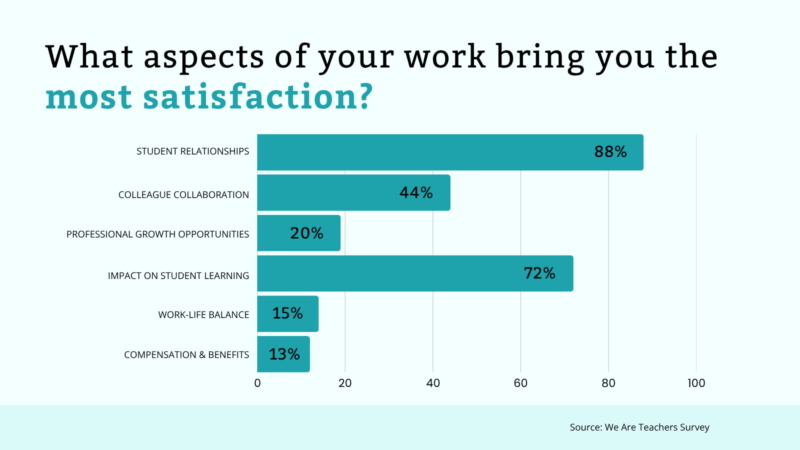
There’s no doubt: Most teachers (90%) get into the field because they want to work with kids. In fact, this is the biggest indicator of job satisfaction. Those who’ve had positive (73%) or very positive (80%) job experiences tend to highly value their ability to have an impact on student learning. “Nothing fills me up more than the relationships I build with my students,” stresses an urban Illinois elementary school educator. “This is the real reason I teach.”
The most satisfied teachers also love working with their colleagues. Nearly half of the educators in our survey (44%) get job satisfaction from collaborating with their peers. “The community we built is here to stay, regardless of turnover and changes in administration,” states one middle school teacher from rural California.
Only about 13% of teachers get job satisfaction from their compensation and benefits.
Teachers definitely don’t get into this field for the money, though many do value the fairly consistent hours and ability to coordinate their time off with their own families’ needs. 15% of them reported work-life balance contributing to their job satisfaction, though.
Teacher Retention Issues: The Causes
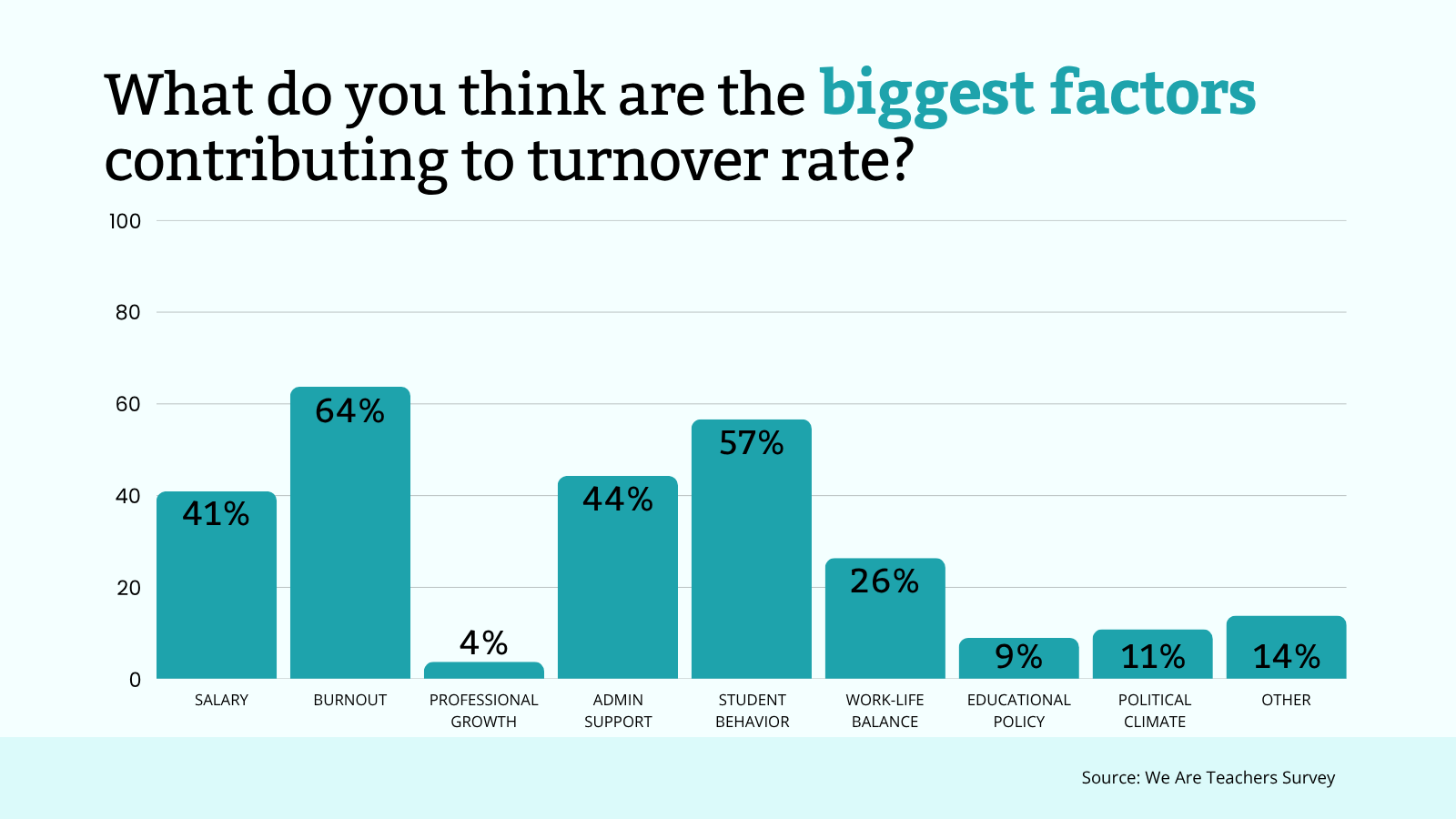
3 out of 5 teachers have considered leaving the field of education in the last year.
That’s 60%, and it’s consistent across all grade levels and years of experience. The number was a bit higher at charter schools (68%).
Burnout (64%) and student behavior (57%) are the biggest factors affecting teacher retention.
So many teachers are just tired. Teacher burnout is real, and more than 3 out 5 teachers believe it’s causing many to leave the profession. “Professionals are entering this field without proper support/training or guidance,” opines an urban Louisiana high school teacher. “This leads to quick burnout.”
62% of educators consider student behavior one of the biggest challenges they face.
Student behavior is another major issue, with about 57% of our survey respondents saying this also leads to poor teacher retention. Some teachers noted that challenging student behaviors require experienced teachers with certifications. But teacher and applicant shortages often mean that the most inexperienced teachers wind up facing the most difficult behaviors. Educators also say that administrators fail to provide the support they need in managing these students.
Nearly half of teachers (44%) say a lack of administrative support leads to teacher turnover.
“Administration has such a big impact,” reports a rural Michigan teacher with more than 20 years of experience. “When I first came to my school, people were leaving other districts to work for our principal because he trusted us to do our job and he encouraged us to be creative and try new strategies. He was also looking for what we did right, so when he talked to us about improving something, we took his words to heart and worked to improve.”
Unfortunately, things can change very quickly, as this teacher’s story shows: “Since that principal’s retirement, we have had unorganized micromanagers who ask us to spend our time doing data entry and writing full-blown daily lesson plans (which they don’t even look at). They are constantly pointing out what we’re not doing or what we’re doing wrong and rarely telling us when we do something well. People have left our school in droves since these changes. … In the last 4 years, we have probably lost 40% of our building staff.”
Teacher pay is another big factor: 41% say low salaries cause teacher turnover.
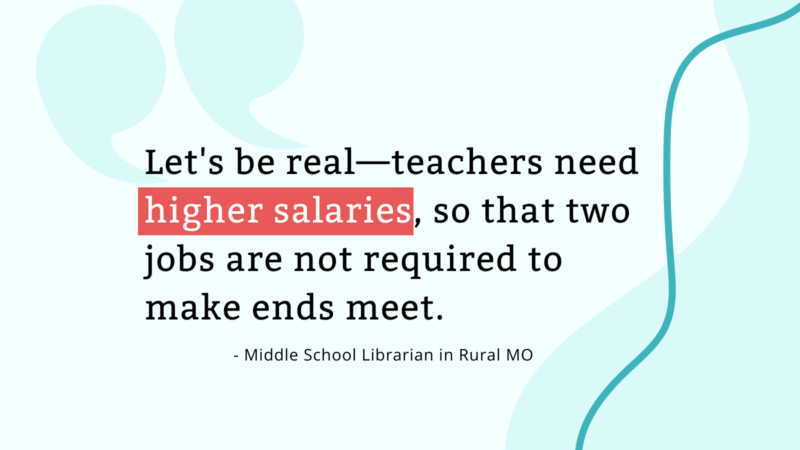
While teachers may not generally get into this field for the money, they do strongly feel they deserve a fair working wage. “My district has not provided a meaningful raise since 2019,” says a public high school teacher in rural Texas. “With inflation, it is getting harder and harder to provide for my family on my salary.”
1 in 10 teachers feel the current political climate makes it harder to retain teachers.
Teachers are worried about the future. Education feels like a more uncertain field in this country than ever before, and that makes retaining teachers harder. Thirty percent of those who considered leaving education in the last year say that our political climate is part of the reason.
Perhaps of more concern, many feel that as our country has become more divided politically, the same divisions are impacting school staff and students. People aren’t treating each other with as much kindness and acceptance, making the work environment uncomfortable for many.
How To Improve Teacher Retention
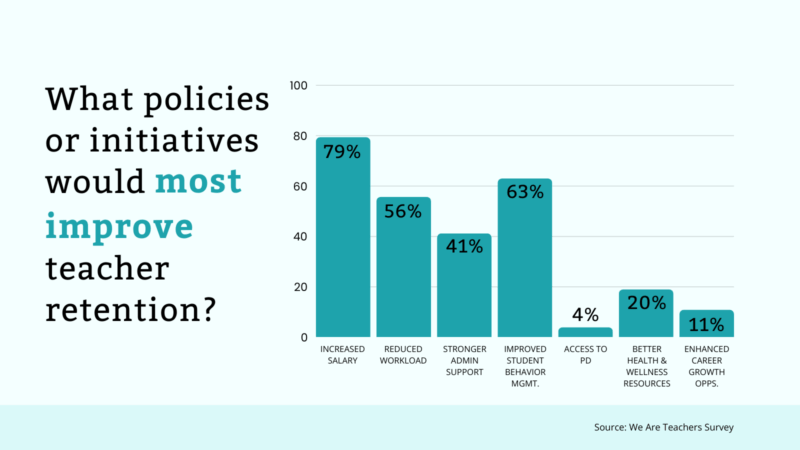
79% of teachers say increasing salaries is vital for teacher retention.
Plus, 62% of those who have already left the teaching profession say that an increase in salary might encourage them to return.
More than half of teachers (56%) say a reduced workload would improve teacher retention.
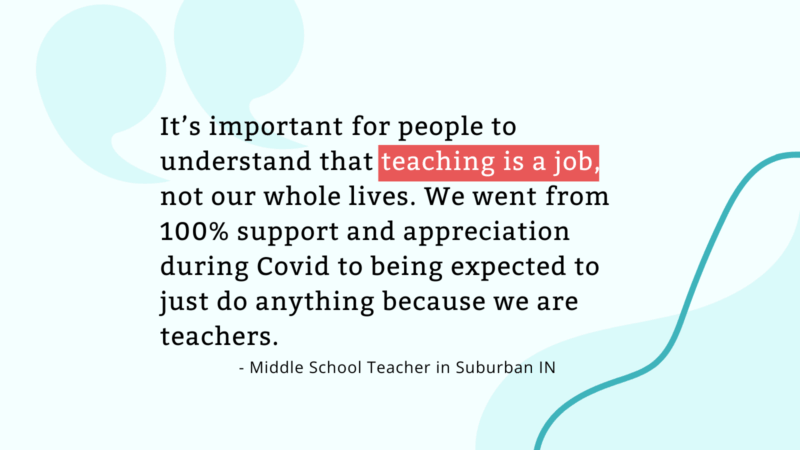
Teachers don’t just feel underpaid, they also say they’re overworked. One teacher said, “There are too many new initiatives and not enough time for curriculum development.” Plus, administrators constantly burden them with extra tasks like recess and lunch duties, student guidance, art, aftercare, before care, and state testing proctoring.
A majority of teachers (63%) think better systems for managing student behavior would entice more teachers to stay.
Teachers are frustrated trying to manage today’s students, whom they say are less interested in learning and harder to engage than past generations. They note that parents are often less involved, while at the same time, kids seem less resilient and resourceful than in years past. Today’s educators want to see more support from both their administration and students’ families.
Nearly three-quarters of educators (73%) say mentorship and peer support may help retain more teachers.
Even teachers who are fully qualified and certified often struggle when they first enter this profession. So much of what it takes to excel in education comes from experience, which you can only gain from time and guidance. Many teachers (nearly half) point to strong support from their peers or even a mentorship program as reasons they’ve stayed in the profession.
Most teachers (60%) don’t think their schools are making any real effort to improve teacher retention or increase job satisfaction.
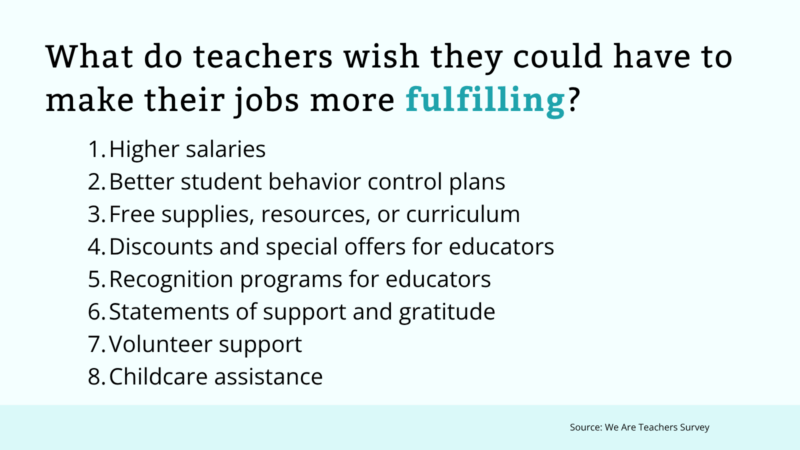
Six out of ten teachers told us that their school doesn’t make any meaningful effort to retain teachers, and that any efforts they do make are fairly small. Things like wearing jeans on Fridays or the occasional free lunch or treat in their mailbox isn’t really enough to overcome the major challenges educators face.
“Our Central Office has started ‘Surprise & Delight’ days where they visit our building and provide drinks or snacks,” an Ohio public elementary school teacher said. “However, it is perceived by staff as toxic positivity because Central Office doesn’t support us when we request real needs such as support with student behavior or providing substitute teachers when we are unmanned.”
Teachers wish they had more community respect and support.
While the educators surveyed indicated they’d love to get free supplies and resources, teacher discounts, and better recognition programs, what they really want from their communities comes down to one word: RESPECT. They want less micromanagement from administration (and the government), more autonomy to do what’s right for their students, and an understanding that they really are experts in their field.
“I am a highly trained professional with multiple degrees and many years of experience and have worked with hundreds of kids,” says one teacher. Another agrees: “Beyond recognition, I think respect is the right word. We want a community that understands that teaching is very hard to do well.”
About the Teacher Retention Survey Respondents
Of the more than 600 teachers that responded to our survey in April 2025, the vast majority (86%) are teachers who work in public schools, with another 3.5% in charter schools. The rest mainly work in private schools. School leaders chimed in too, making up about 5% of the results. We also heard from librarians and literacy specialists, school counselors, paraeducators, subs, and instructional coaches, among others.
Most of our respondents are long-term educators—about four out of five have been in the profession 11 years or more, and more than half of them have been working in the field 21+ years. They were fairly evenly split among elementary (40%), middle (26%), and high school (34%), offering a balance of experiences across grade levels.
Of the 50 U.S. states, 49 were represented in the survey, with about half of the educators surveyed teaching in suburban schools, a third in rural schools, and the rest in urban environments.
Our friends at Staples Business want you to know that they understand how hard it is to make your school budget meet your school needs—that’s why they promise:
- All the right products, one supplier. Streamline your ordering process across multiple categories: facilities, tech, furniture, print services and more.
- Save 20% on school supplies vs. a major competitor. Find all the brands that teachers and parents trust.
- Next-day delivery to over 98% of the U.S. Rely on arrival during school hours, and schedule deliveries up to 150 days out.
- 100% satisfaction guaranteed. Outfit your school with trusted quality and everyday value from our Staples family of brands.
- Experts always ready to help. Get strategic guidance, K-12 product recommendations, cost-saving insights and more
- Red tape, eliminated. Count on our publicly solicited and awarded contracts with the top cooperative.
You’ve got everything to gain, go find out more at Staples Business.


